POSTPONED Experimentations 12: Images of Broken Light: Indexicality in Astronomy II
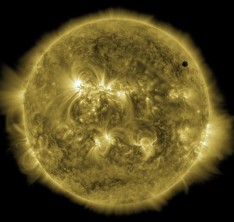
Venus Transit 2012 (NASA)
Los Angeles Filmforum presents
Experimentations: Imag(in)ing Knowledge in Film, Program 12
Images of Broken Light: Indexicality in Astronomy II
Sunday January 12, 2025, 3:00pm
At 2220 Arts + Archives, 2220 Beverly Blvd., Los Angeles CA 90057
NOTE THE CHANGE IN TIME
Tickets: $15 general, $10 students/seniors, free for Filmforum members
$20 for both programs today
https://link.dice.fm/B666595db371
The program will be followed by a panel with Jane de Almeida, Lilly Husbands, Eames Demetrios, and Brian Jacobson in person, and filmmakers Derek Jenkins, Anna Sigrithur, and Joel Penner on Zoom.
A free dinner will be available after the panel!
This showcase presents a series of films related to astronomy that examine how scientific knowledge depends on traces left directly by natural phenomena themselves - so-called indexical images. Before being ideas, scientific theories are themselves constituted by image making. With computer-generated imagery, it has become increasingly difficult to recognize the indexicality of the film image, mainly because of simulation. In the case of scientific films, this issue is even more delicate, as the image requires a direct recognition of reality, under penalty of not constituting scientific evidence. With increasingly aestheticized images, scientific images in turn are captured from distant spaces, through sophisticated hybrid technologies, very different from the optical array images of telescopes. This screening intends to present an overview of films considered scientific, with educational intentions on astronomy since before the invention of cinema, so that the most diverse film techniques used by filmmakers and scientists in different eras can be appreciated.
The selection begins with Passage of Venus (1874), when astronomer Jules Janssen first used sequential photography to record Venus crossing the sun's surface.Declaring the photographs were “drawn by the sun, himself”, Janssen persuaded the astronomical community for replacing hand-made observational drawings with this new scientific instrument. Since then, the relationship between science and image representation has been marked by an ongoing tension over the role of instruments - from cameras to computers - as tools of precision measurement and observation. In the digital age, the concepts of "imaging," animation, and simulation introduce new potentials and complexities. Contemporary instruments - radio telescopes and infrared detectors - capture data beyond visible light, demanding new visualization methods and interpretation. This transformation invites us to rethink the nature of scientific evidence and the role of imaging in the construction of astronomical knowledge, at a time when the boundary between recording and simulation becomes increasingly blurred.
In this screening, some of the films show how the images directly captured from nature are used in cinematic fashion, and also for educational purposes. Bernard Lyot captured unprecedented images of the sun using the coronagraph he developed, creating a film from this footage. Flammes du Soleil, created later to honor Lyot, presents his solar footage as a choreographed spectacle, anticipating today's computer-simulated astronomical images stored in observatory and laboratory databases. This approach to astronomical visualization continues with Cosmic Cycles: A Space Symphony from NASA's Goddard Space Flight Center, which merges diverse astronomical images into a journey through space, exploring the universe as a musical symphony. Planetary Fantasia is scored by the National Philharmonic with the composition by Henry Dehlinger.
Equally remarkable but educational in purpose, the Cosmos TV series (1980-81), hosted by Carl Sagan, cinematically featured Voyager spacecraft imagery alongside the first computer images. Jim Blinn manipulated Voyager's data and photographs to create what became known as a "computer simulation," showcased in the Cosmos episode The Persistence of Memory. Blinn's groundbreaking work featured a computer-rendered Voyager spacecraft orbiting Jupiter, creating a fly-by simulation that pioneered new computer modeling techniques.
The next two films demonstrate speculative image techniques that foresaw future discoveries and instruments. Pavel Klushantsev's Road to the Stars, a Soviet science film, anticipated later achievements: humanity's first steps on lunar soil, crewed spaceflight, and scenes that would influence (or be copied by) Kubrick's 2001: A Space Odyssey. Combining science education and speculation, the film provides historical context through the work of rocketry pioneers: Konstantin Tsiolkovsky, Max Valier, and Robert Goddard. During the film's editing, Sputnik - Earth's first artificial satellite - was launched, marking a triumph for the Soviet Union. Government officials demanded additional scenes be included before the film aired in November 1957, one month after Sputnik's launch. For 92 days, Sputnik broadcast its iconic "beep...beep...beep" radio signals worldwide. Though seen as a geopolitical space toy, it launched a new era of space exploration. Sputnik 2 and 3 established two key paths: human missions (beginning with Laika the dog) and robotic observation.
Powers of Ten, directed by Ray and Charles Eames, used cleverly layered photographs to simulate continuous zooming in and out from human scale. The film shifts from traditional central perspective to a logic of scalability - moving between telescopic and microscopic views in powers of 10, foreshadowing today's Google Earth visualization approach.The film anticipates computerized ways of seeing images as a scopic field - understanding the world not through opposites or central perspective, but through scaling between global and local, micro and macro dimensions.
The screening concludes with Tom Bridgman's exquisite 2012 Venus transit visualizations for NASA/Goddard's Scientific Visualization Studio. These pieces stand in counterpoint to Janssen's documentation of the 1874-1888 transit cycle, creating a dialogue between historical and contemporary imaging tools. The next Venus transit awaits in 2117.
The program will be followed by a panel with Jane de Almeida, Lilly Husbands, Eames Demetrios, and Jheanelle Brown in person, and filmmakers Derek Jenkins, Anna Sigrithur & Joel Penner on Zoom.
A free dinner will be available after the panel!
Curated by Jane de Almeida, Adam Hyman, Jheanelle Brown.
Jane de Almeida is an interdisciplinary researcher working at the intersection of arts, film, and new media, with a focus on subjectivity and perception. Her international academic career includes positions as Visiting Scholar in the Department of Philosophy at Boston College, Visiting Fellow in the Department of Architecture and History of Art at Harvard University, and guest researcher at MediaLabMadrid. She further expanded her research as a Visiting Professor in the Visual Arts Department at the University of California, San Diego, where she also served as artist-in-residence at the Arthur C. Clarke Center for Human Imagination, developing the project Loga: Mars Projections. Currently, de Almeida is a professor in the Arts Department at the Catholic University of São Paulo, Brazil, while coordinating the Laboratory of Scientific Image (LIC) at the State University of Campinas (UNICAMP). Her curatorial work spans exhibitions including "Harun Farocki: Programming the Visible" at Paço das Artes, "Off the Radar" at the Visual Arts Gallery at UC San Diego, "Ulla, Ulla, Martians, Intergalactics and Aliens" at Casanova, “Black Zero: Aldo Tambellini” at Casanova and Museum of Modern Art (MAM) of São Paulo, and "Quantum Art" at FILE. She also curated the exhibition "Ordering and Vertigo," which was showcased at the Cultural Center Bank of Brazil (CCBB) across multiple locations including Rio de Janeiro, Brasília, and São Paulo.
Eames Demetrios works in the areas of design, art, filmmaking and storytelling. In the design world, Demetrios is probably best known as director of the Eames Office, taking care of the legacy of designers Charles and Ray Eames for almost three decades. In this capacity,and working with his siblings, he has organized and curated numerous exhibitions, stewarded the re-editions of the Eames Furniture with Herman Miller and Vitra, and created an interactive version of the classic Eames film Powers of Ten. In addition, Demetrios is Chairman of the Board of the Eames Foundation, which takes care of the remarkable Eames House.
Demetrios is a writer as well: he’s the author or co-author of a dozen books and contributor to many more. His current large scale art work is his parallel universe, Kcymaerxthaere, a global work of multivalent storytelling, telling stories through the physicality of the world. For this project he has, over the past 20 years, installed 157 public installation in 30 countries on 6 continents in 31 languages. Demetrios describes it as a global sculpture made out of narrative. Demetrios continues to do some filmmaking, having made over 70 films (mostly short documentaries, but some fiction features and animation)--many on the Eames work, as well as exploring topics ranging from the Modern Maya of southern Mexico to Frank Gehry, from homelessness to legendary winemaker Peter Gago.
Brian Jacobson is Professor of Visual Culture at the California Institute of Technology and Director of the Caltech-Huntington Program in Visual Culture. He is the author of The Cinema of Extractions: Film Materials and Their Forms (Columbia, 2025) and Studios Before the System: Architecture, Technology, and the Emergence of Cinematic Space (Columbia, 2015) and has edited the multi-award-winning book, In the Studio: Visual Creation and Its Material Environments (California, 2020), and “Media Climates,” the Winter 2022 issue of Representations.
Lilly Husbands is a lecturer in Animation and Visual Culture at Middlesex University. Her research is broadly concerned with the legacy and evolution of experimental animation in the context of contemporary multimedia practice. She has published numerous book chapters and articles on experimental animation in journals such as Moving Image Review & Art Journal (MIRAJ), Frames Cinema Journal and Alphaville: Journal of Film and Screen Media. She is the co-editor of the book Experimental Animation: From Analogue to Digital (London: Routledge, 2019). She is an associate editor of Animation: An Interdisciplinary Journal.
Derek Jenkins (Canada/USA) is a motion picture photographer born in Monroe, Louisiana in 1980. His practice is handmade, personal, and documentary—sometimes all at once. His films have been exhibited at festivals, museums, and galleries, including DocLisboa, Alchemy Film and Moving Image Festival, McMaster Museum of Art, Antimatter Film Festival, the8fest, FRACTO Experimental Film Encounter, Media City Film Festival, Mimesis Documentary Festival, non-syntax Experimental Image Festival, Microscope Gallery, and Prismatic Ground, among many others. Previously a technician at Niagara Custom Lab, he is Executive Director of Hamilton Artists Inc., founder of Dandelion Film Collective, and board chair at the Canadian Filmmakers Distribution Centre. He lives and works in Hamilton, Ontario.
Anna Sigrithur is a writer and artist whose work explores language, sensory perception and human/non-human relationships.
Joel Penner is a filmmaker who uses scanners, microscopes and cameras to create time lapses of plants and fungi growing and decaying, with the goal of inspiring people to see the beauty of everyday existence.
Experimentations: Imag(in)ing Knowledge in Film is Filmforum’s expansive film series and upcoming publication that investigates the ways that experimental and scientific films produce and question the visualization of the world. Combining artist films utilizing scientific imagery, science and natural history films, and films of indigenous and traditional knowledge, the series examines how science, nature, and technology films shape our understanding of humans, nature, gender, knowledge, and progress. The multi-venue public screening series presents analog and digital time-based media incorporating diverse scientific and experimental film traditions from across the globe. The series will include eighteen screenings between September 2024 and February 2025, with films and digital works from 1874 to today from around the world, multiple guests, panels and wonderful collaborations that will reveal the possibilities and circumstances of cinema in this realm. For more, please visit www.filmforumexperimentations.org
Experimentations: Imag(in)ing Knowledge in Film is among more than 70 exhibitions and programs presented as part of PST ART. Returning in September 2024 with its latest edition, PST ART: Art & Science Collide, this landmark regional event explores the intersections of art and science, both past and present. PST ART is presented by Getty. For more information about PST ART: Art & Science Collide, please visit: pst.art.
Major support for Experimentations: Imag(in)ing Knowledge in Film is provided by the Getty Foundation and The Andy Warhol Foundation for the Visual Arts. Additional Support from the Los Angeles County Board of Supervisors through the Los Angeles County Department of Arts & Culture, and the Department of Cultural Affairs, City of Los Angeles.


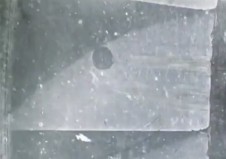
Passage artificiel de Vénus sur le Soleil (1874)
Passage artificiel de Vénus sur le Soleil
Pierre Jules César Janssen, France/Japan, 1874, digital, b/w, silent, 0:30
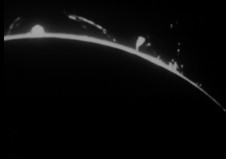
Flammes du soleil
Flammes du soleil
By Bernard Lyot, 1935 with added commentary by Paul Couderc, 1957, b&w, sound, 11:00
Film made in memory of Bernard Lyot, astronomer, member of the Academy of Sciences and inventor of the coronagraph.
Paul Couderc, astronomer at the Paris Observatory, comments on the images that Bernard Lyot made in 1935. Lyot invented the coronagraph which allowed filming of the sun, the solar corona, the protuberances and the columns of gas on the surface of the sun.
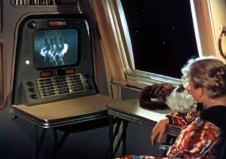
Road to the Stars (Дорога к звёздам)
Road to the Stars (Дорога к звёздам)
Pavel Klushantsev, USSR, 1957, digital transfer, color, sound, 25 min.
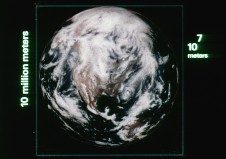
Powers of Ten. Courtesy of the Eames Office
Powers of Ten
Charles and Ray Eames, USA, 1977, digital, color, sound, 9:00
Powers of Ten and the Relative Size of Things in the Universe (1977) is a film created by the Eames Office investigating the idea of an exponential series. The film illustrates scale and the significance of adding a zero to a number. It begins with a scene on Earth: a man and woman picnicking in a park bordering Lake Michigan in Chicago. The journey unfolds as the camera steadily moves away from the couple, reaching the edge of the known universe. The camera reverses its movement back to Earth’s park scene, going further to reach the atomic level of the hand of the napping man on the picnic blanket. Original music score by Elmer Bernstein.
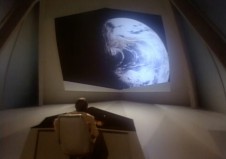
Cosmos: A Personal Voyage, excerpt from Episode 11
Cosmos: A Personal Voyage
Carl Sagan/Ann Druryan, USA, 1980, digital, color, sound, 10 min.
Excerpt from Episode 11 “Persistence of Memory”
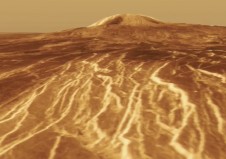
Cosmic Cycles 5: Planetary Fantasia
Cosmic Cycles 5: Planetary Fantasia
James Tralie, Wade Sisler, and Henry Dehlinger, USA, 2023, color, sound, 12:36,
Courtesy NASA's Goddard Space Flight Center
Producers: James Tralie (ADNET Systems, Inc.), Wade Sisler (NASA/GSFC)
Editor: James Tralie
Music composer: Henry Dehlinger (National Philharmonic)
Music credit: “Planetary Fantasia" from Cosmic Cycles: A Space Symphony by Henry Dehlinger. Courtesy of the composer.
Earth’s siblings, the other planets were created at the birth of the solar system. They give us a glimpse of the variety possible in the universe and how rare Earth is. As we explore these other worlds, we fuel our adventurous spirit and discover new wonders at every turn: riverbeds on Mars, volcanoes on Jupiter’s moon Io, auroras on Saturn, and sulfuric-acid clouds on Venus.
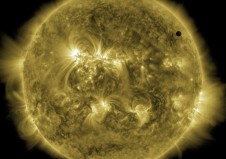
Venus Transit 2012 Composited Visuals
Venus Transit 2012 Composited Visuals
Tom Bridgman, 2012, digital, color, silent, 3 min.
Visualizations by: Tom Bridgman / NASA
A high-cadence view of Venus Transit in HMI. 1:06
A high-cadence view of Venus Transit in AIA at 304 angstroms 37 seconds
Composited Full Disk frames, constructed by compositing the AIA 171 high-cadence inset with the low cadence full-resolution disk. 38 seconds
